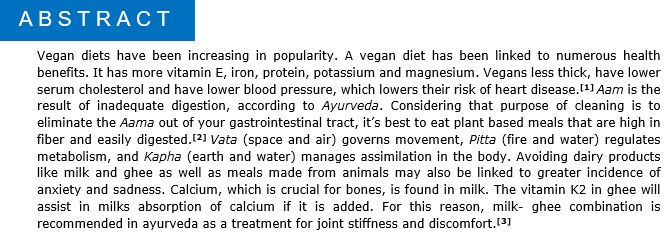Vegan diet consumption according to Prakrti mentioned in Ayurved (Vata, Pitta, Kapha)
DOI:
https://doi.org/10.21760/jaims.8.8.24Keywords:
Vegan Diet, Vata, Pitta, Kapha, Prakriti, Ayurveda, Calcium & Vitamin B12 Deficiency, Heart Disease, Food and NutritionAbstract
Vegan diets have been increasing in popularity. A vegan diet has been linked to numerous health benefits. It has more vitamin E, iron, protein, potassium and magnesium. Vegans less thick, have lower serum cholesterol and have lower blood pressure, which lowers their risk of heart disease.[1] Aam is the result of inadequate digestion, according to Ayurveda. Considering that purpose of cleaning is to eliminate the Aama out of your gastrointestinal tract, it’s best to eat plant based meals that are high in fiber and easily digested.[2] Vata (space and air) governs movement, Pitta (fire and water) regulates metabolism, and Kapha (earth and water) manages assimilation in the body. Avoiding dairy products like milk and ghee as well as meals made from animals may also be linked to greater incidence of anxiety and sadness. Calcium, which is crucial for bones, is found in milk. The vitamin K2 in ghee will assist in milks absorption of calcium if it is added. For this reason, milk- ghee combination is recommended in ayurveda as a treatment for joint stiffness and discomfort.[3]
Downloads
References
Stahler C. how many adults are vegetarian? Veg j 2006; 25: 14-5.
Sharma PV, editor. Charak samhita. (vol 1). Varanasi: chaukhambha orientalia; (2001)
Tunick M.H. van hekken D.L. dairy products and health: recent insight. J. agric. Food chem. 2015;63:9381 – 9388. Doi: 10.1021/jf5042454. [pubMed] [crossRef] [google scholar]
timesofindia.indiatimes.com/blogs/voices/how-is-vegan-food-disrupting-the-indian-market/
Yadavji Trikamji. Charak Samhita, Sutra Sthana 20, edited by Acharya, 4th edition, Chaukhamba surabharati publications, Varanasi. 1994
https://www.healthline.com/nutrition/7-nutrients-you-cant-get-from-plants#The-bottom-line
Wolffenbuttel B. H. R., Wouters H. J. C. M., Heiner‐Fokkema M. R., van der Klauw M. M., Mayo Clin Proc Innov Qual Outcomes 2019, 3, 200.
Institute of Medicine. Dietary reference intakes for vitamin A, vitamin K, arsenic, boron, chromium, copper, iodine, iron, manganese, molybdenum, nickel, silicon, vanadium, and zinc. http://www.nap.edu/download.php?record_id=10026. Accessed April 15, 2016.
Kaviraj Ambikadutt Shastri. Sushruta Samhita with Ayurveda tatva Sandipika Hindi commentary, Sutra Sthan. Chaukhmba Sanskrit Sanstha, Varanasi; 2014.















